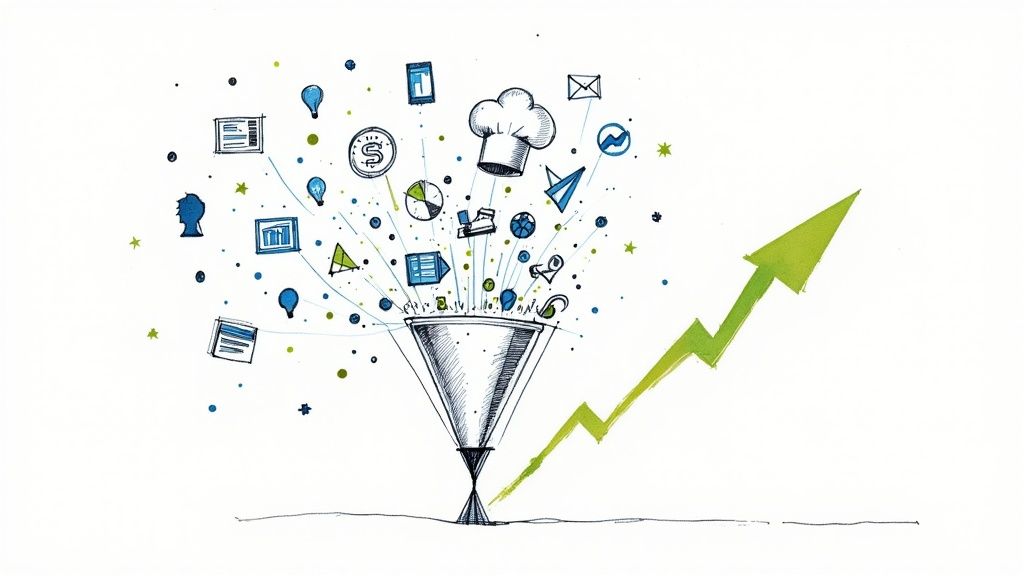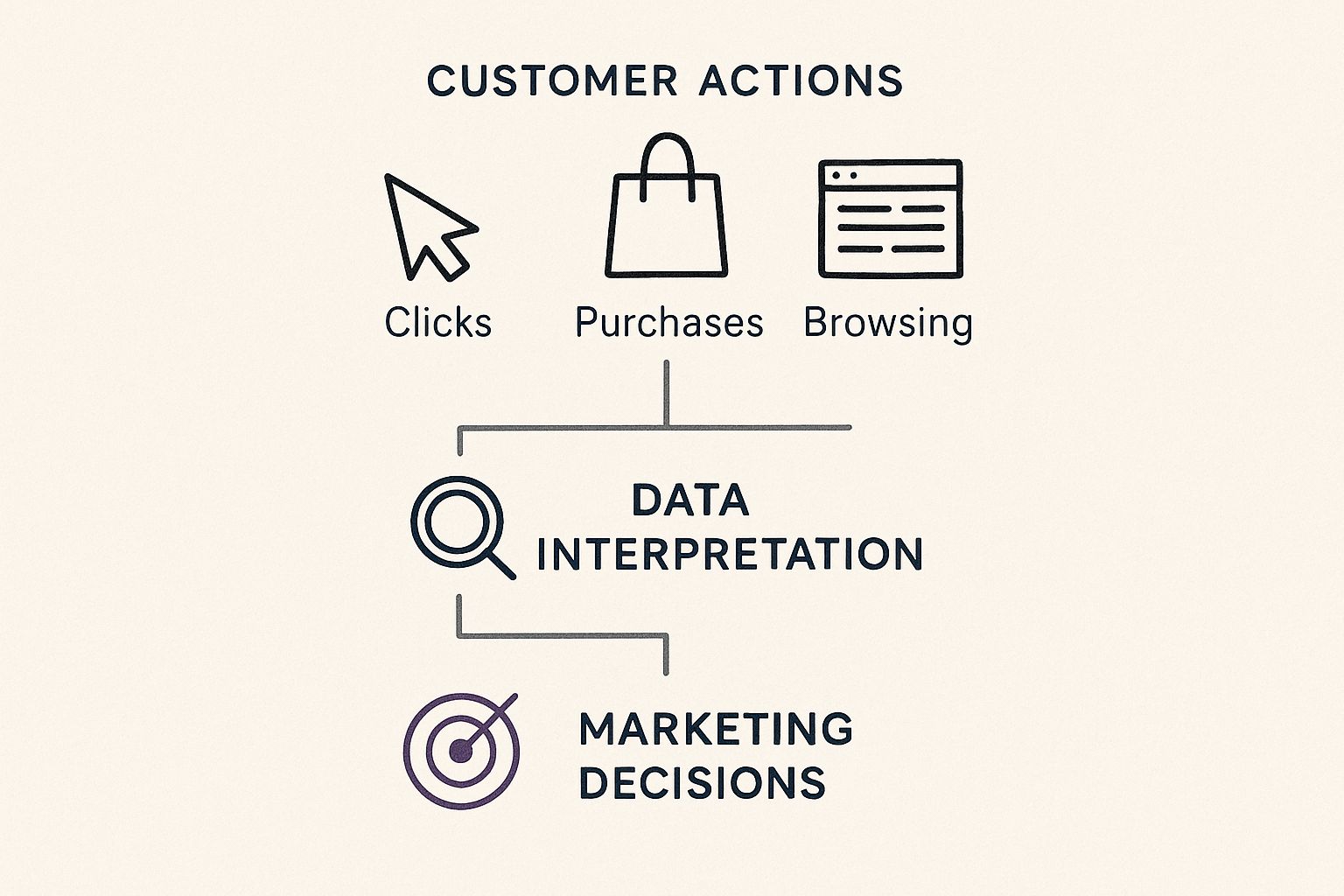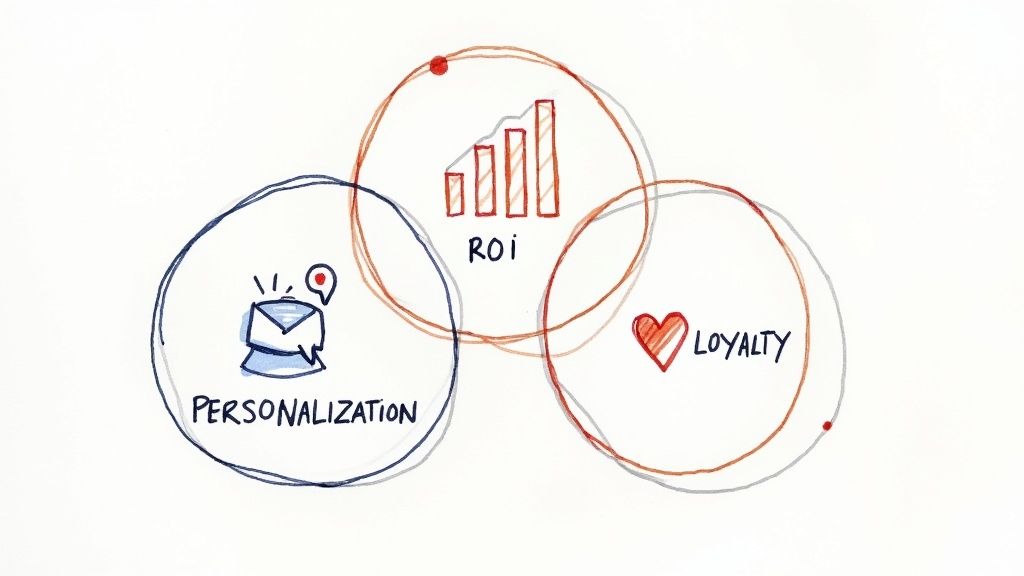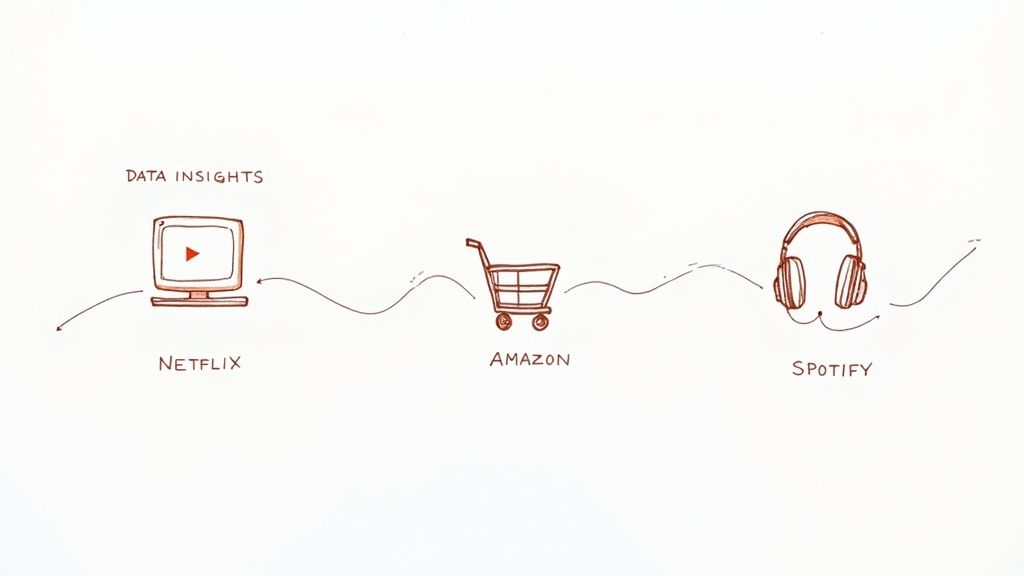
Mastering Lead Generation for Healthcare: Proven Strategies for 2025
Master lead generation for healthcare with proven strategies for 2025. Learn to attract, nurture, and convert quality leads in the complex healthcare market.

At its core, data-driven marketing is all about using real, hard facts about your customers to guide your marketing efforts. We're talking about their clicks, what they buy, how they browse your site—all the little digital breadcrumbs they leave behind.
Instead of guessing what might work, you're making decisions based on what you know works. It's less about gut feelings and more about listening to what customers are telling you with their actions.
Think of it this way: a traditional marketer might be like a chef who follows a recipe exactly, hoping for the best. A data-driven marketer is more like a chef who constantly tastes the sauce, adjusts the seasoning, and tweaks the heat to get it just right.
Every time a customer interacts with your brand, they're giving you a clue. Data helps you piece those clues together to see the full picture, allowing you to build stronger relationships and deliver exactly what people are looking for.
This infographic breaks down how that process works, turning customer behavior into smart marketing moves.

It’s a simple loop: watch what people do, figure out what it means, and then act on that insight. This isn't just a trend; it's a must-do. In fact, 64% of marketing executives "strongly agree" that data-driven marketing is crucial for success in a competitive market.
Why the big shift? The modern customer journey is incredibly complex, sometimes involving anywhere from 20 to over 500 touchpoints before a purchase is made. Without data, navigating that would be impossible.
The data-driven approach allows for much more specific and effective campaigns. For example, a sophisticated strategy like Account-Based Marketing (ABM) treats a single high-value company as its own market, a level of focus only possible with deep data insights.
By analyzing customer data, businesses can achieve a deeper understanding of their audience, leading to more relevant messaging, improved customer experiences, and ultimately, a higher return on investment.
Instead of casting a wide, expensive net and hoping for the best, data lets you aim a spotlight right where it needs to be, focusing your time and money on what actually works.
A successful data-driven marketing strategy is built on a few essential pillars that work together, turning raw information into real business results and creating a repeatable process for growth.

It all begins with gathering the right signals.
The foundational pillar is Data Collection. This is where you gather information from every customer touchpoint—website clicks, social media interactions, purchase history, and even offline interactions. The goal is to build a complete picture of how customers engage with your brand.
Once you have the data, the next pillar is Data Analysis. This is where you sift through information to find meaningful patterns. You might discover that customers who watch a product video are 50% more likely to buy, or that a specific blog post is your best source of qualified leads. This is the moment raw numbers start telling a story.
Finding a pattern is one thing, but turning it into a concrete plan is what truly matters. The third pillar, Actionable Insights, is about translating findings into specific marketing actions. For instance, if data shows a spike in cart abandonment on the shipping page, the insight is to simplify that step.
The final, and arguably most important, pillar is Measurement. This means tracking the performance of your actions to see what actually worked. Did simplifying the checkout process really lower your abandonment rate?
This continuous loop of collecting, analyzing, acting, and measuring is the engine that drives any effective data strategy. A key part of measurement is understanding which marketing efforts deserve credit. You can learn more about attribution modeling to figure out which channels are truly delivering results.
When you ground your marketing in solid data, you build smarter strategies that improve your bottom line. It’s a shift from guesswork to informed action.
Perhaps the biggest win is the power to personalize your marketing in a way that truly connects with people, and do it for thousands of customers at once.

This means you can stop blasting the same generic message to your entire audience. Instead, you can have meaningful conversations with individual customers, all guided by their real-world behaviors.
This approach has a direct effect on your return on investment (ROI). By digging into performance data, you can pinpoint which marketing channels are bringing in revenue and which are just burning your budget. It lets you confidently double down on what’s working.
When you understand your customers, you can design experiences that build real loyalty. When people feel seen and understood, they're far more likely to stick around.
And the data doesn't lie. Companies that fully embrace data-driven marketing see a 5–8 times higher return on investment (ROI) than those still flying blind. You can read the full research on data-driven marketing ROI to see just how big the impact can be.
In the end, using data isn't just about being more efficient. It's about being more effective. You make better decisions, forge stronger customer relationships, and get a financial return that guesswork could never deliver.
Focusing on these results is key to knowing if your campaigns are truly successful. If you want to get into the details, check out our guide on how to measure marketing ROI to connect your activities to actual revenue.
Jumping into data-driven marketing can feel overwhelming. You might be picturing complex dashboards and a team of data scientists, but that’s not where you need to start. The secret is to begin small, focusing on one clear goal.
Think of it like learning to cook. You wouldn't try to master a five-course meal on your first day. You’d start by perfecting a single recipe. In marketing, that means picking one specific objective—like reducing cart abandonment—and building your first data-driven experiment around it.
Getting started is about asking the right questions and taking small, smart actions. A free tool like Google Analytics holds a treasure trove of information that can guide your first few moves.
Here’s a simple, five-step process to get you going:
This cycle—goal, data, hypothesis, test, learn—is the engine of all data-driven marketing. It’s not about getting it perfect the first time; it's about continuously learning and improving.
This approach takes the pressure off. Instead of trying to boil the ocean, you're just taking one manageable step at a time.
You don’t need an enterprise-level technology stack from day one. A few key tools can provide all the data you need to get started. Here’s a quick look at the core categories.
These tools are more than enough to help you find valuable insights and run your first few successful campaigns.
The best way to understand data-driven marketing is to see it in action. Let's look at how some of the world's biggest companies use data to create experiences their customers love.
Take Netflix, for instance. They do more than just recommend your next binge-watch. They analyze viewing data across millions of subscribers to decide which multi-million dollar shows and movies to greenlight. It's a calculated bet on content they're confident already has a hungry audience.

This "data-first" mindset turns audience behavior into a roadmap for content creation, minimizing financial risk while maximizing viewer engagement.
Think about Amazon's recommendation engine. It's famous for a reason. By looking at your browsing habits, purchase history, and even what you've added to your cart, it builds a storefront that feels like it was made just for you. This system drives a huge chunk of the company's total sales.
Spotify offers another brilliant twist with its yearly "Wrapped" campaign.
By packaging a user's personal listening data into a fun, highly shareable story, Spotify creates a viral marketing event. This campaign reinforces customer loyalty and generates massive organic buzz, all by showing users a reflection of their own habits.
Each of these giants proves the same core point. Whether it's producing a new series, recommending a product, or building a viral campaign, the strategy is fueled by listening to what customers are already doing.
These brands show that the most effective marketing doesn't feel like marketing—it feels like a genuine conversation. For businesses hoping to build similar strategies, partnering with a skilled data-driven marketing agency can be the key to turning raw numbers into real growth.
The world of data-driven marketing never sits still, and the next big leap is all about Artificial Intelligence (AI). Think of AI as an engine supercharging our ability to make sense of massive, complex datasets. It’s moving us beyond simply analyzing what happened to actually predicting what’s coming next.
This isn't just about faster analysis. It's about anticipating what customers will want or do, sometimes even before they know it themselves.
AI is no longer a "someday" tool; it's here now. It's expected that by 2025, a staggering 63% of marketers will be using generative AI in their daily work. In pay-per-click, 75% of PPC professionals are already using it for things like drafting ad copy.
This isn't just about automating old tasks; it's about fundamentally rethinking our strategies. Getting a handle on how to use AI in marketing is quickly becoming essential for anyone who wants to create campaigns that connect with people today.
With great data comes great responsibility. The more powerful our tools become, the more critical ethical considerations are for building and maintaining customer trust.
As our technology gets smarter, the human touch becomes more important than ever. AI is fantastic at crunching numbers and executing tasks at lightning speed, but it can't replicate human creativity, strategic insight, or a strong ethical compass.
The real win in the future of data-driven marketing will come from the partnership between intelligent tools and skilled, thoughtful marketers. The best strategies will always be the ones that blend AI-powered insights with genuine human creativity, building lasting customer relationships founded on trust.
Ready to harness the power of AI and data for your business? At BrandBooster.ai, we combine expert strategy with advanced technology to deliver real results. We guarantee a return on your ad spend in 60 days, or you don't pay. https://www.brandbooster.ai